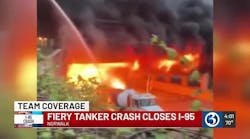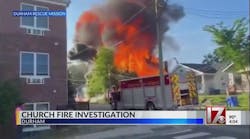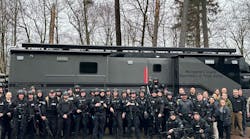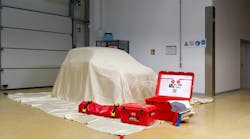I'm a relative newbie when it comes to telling fire department stories…BUT, when I joined the fire department, we wore three-quarter boots and un-insulated leather helmets and we rode back steps, side steps and any place else where we could stand. Those who told ME stories would say, “Boots? We didn’t wear no stinkin’ boots! And leather helmets? That’s for wusses – we wore tin helmets.” It was like the tales my grandfather would tell me about “walking barefoot to school, two miles uphill both ways, in three feet of snow.”
Well, I’m here to tell you (AGAIN) that this ain’t your grandfather’s fire department any longer (a future article title, I’m sure)! The funny thing is that for the purposes of this topic/article, your grandfather’s fire department PROBABLY got it right!
Look at the science
If you haven’t heard about the flow path studies that have been taking place, then you need to come out from under your rock more often! The National Institute of Standards and Technology (NIST) and Underwriters Laboratories (UL) have teamed up to show the science behind the paths that smoke, fuel-rich hot gases and fire take. While we generally always knew this, the NIST and UL studies have validated the fact that building conditions, open/closed doors and windows and fire department actions have a direct impact on the flow paths that affect both firefighter/public safety and property conservation.
How many of us have actually taken a look at the science and made changes to our operational procedures? While there are many others, I can tell you that the Fire Department of New York, Chicago Fire Department, Oklahoma City Fire Department, Los Angeles County Fire Department and, yes, the Prince George’s County, MD, Fire/EMS Department (PGFD) have taken a look – and we have all changed (or are in the process of changing) our operational procedures.
So, back to stories. It was a badge-of-honor to be a truckie breaking out every window we could find, leaving hanging shards of glass, screen and blinds waving as a live picture of our valiant work! We did eventually grudgingly learn that is was important to clean all the glass and dangling debris to make our exit out of that “super-heated” room easier.
And the older stories...“We had to knock it down from the outside...because we didn’t have breathing apparatus – just a sponge in our mouth, a T-shirt pulled up over our nose. Oh yeah, we would DIE before coming out of there if the fire was still burning. We pulled those people out, but hell, if I couldn't make it in with my rubber coat and tin helmet, what kind of chance did they have?” To which I and others would respectfully listen and then have an exchange something like this: “WHHAATT? KNOCK IT DOWN FROM THE OUTSIDE? OH MY GOD, NO WONDER THOSE PEOPLE DIED! Our gear and SCBA let us go sooo much farther inside now – we probably could have saved those people!”
Enter Dan Madrzykowski (NIST) and Steve Kerber (UL) with their pocket protectors and iPads! Recently referred by some in tongue-and-cheek comments as the antichrists of the fire service, together Dan and Steve have turned our 21st century fire suppression culture on its back.
What we know (again) now, is that your grandfather’s fire department probably had it right by knocking it down from the outside. And every one of those broken windows we so PROUDLY demolished created a potential flow path, which ultimately could provide an easy exit point for smoke, heated gases and fire (as opposed to NOT creating that path). These broken windows also had the potential to provide an entry point for fresh air. The oxygen in the air, mixing with the heated fuel gases (a/k/a smoke or products of combustion), sets the stage for a ventilation-induced flashover.
Yeah, yeah, heard it and said it a thousand times, “You’re going to FRY those people inside if you push that fire back in on them”; “You’re going to burn the place down by pushing the fire IN the house”; “We’ll be THOSE wusses if we do that”; “The steam will kill them if the fire doesn’t”; “We have to take all the windows our so we make sure we can get out – or so we can pull the residents out.” The frying, pushing, steaming and wussiness is all a crock of crap (CoC) – the scientific research and fundamental testing completed in New York and Chicago provides irrefutable proof that we had it wrong.
There is no argument that ventilation is an important tactical consideration and is fundamentally necessary in structural fire environments. In the past, we did (what we now know is) a poor job of considering the entire scenario and applying (in an instant) the principles of fire science. A fire that has already vented through the roof generally doesn’t need another hole cut in the roof (providing another flow path) during active burning – in fact, the control of fire and the simultaneous control of ventilation go hand-in-hand.
Remember that truckie badge-of-honor? For the outside team, that was our first task as we went around the house, to take out every window we could reach – no coordination, no consideration. If there were enough people, we also sent a first team to the roof – “open it up.” Our training taught us and we believed those things and provided the ventilation that was critical for the firefighters going inside, whether they were in there yet or might be soon. We know now that each of the holes we cut and each of the windows we opened provided yet ANOTHER flow path that didn’t exist before we cut the holes or broke the windows. We also know that it is critically important to coordinate fire attack and ventilation, applying water as quickly as possible to the fire and starving oxygen as long as possible by limiting ventilation openings until the fire attack has begun.
The fire attack part of this is equally disturbing for that “old guy.” We know now that “resetting” the fire by lobbing water in a window might be the quickest and safest way to limit injuries, deaths and property damage. WWHHAATT? Your grandfather’s fire department MIGHT have had this right! The tactical advantages of resetting the fire from the outside have to be weighed at each individual fire scene – I will not tell you that EVERY fire should be hit from the outside first. After obvious rescues, the two most important factors to be considered together are (1) Existing and potential flow paths and (2) The safest and quickest way to get water on the fire.
In February 2012, the PGFD experienced a “typical, bread-and-butter” fire incident in a single-family home in the Riverdale Heights area of the county. This was a “Red-Flag” day, with extremely low relative humidity and strong westerly winds blowing across the county. First-arriving units from Riverdale and Bladensburg encountered a small ranch-style home (single-story front, two-story rear). There was fire showing from a window on the basement level at the Bravo/Charlie corner. Winds gusted over 40 mph from the rear of the house to the front – smoke banked to the ground, totally obscuring the area blowing across the street. Including a car in the driveway, every indication pointed to this as an occupied structure.
The engine crew from the Riverdale Volunteer Fire Department, following standard procedure, advanced an attack line to the front door. The truck crew from the Bladensburg Volunteer Fire Department (arrived at same time), following standard procedures, had an interior crew of two ready to enter with the engine crew. The blinding smoke was banked to the ground across the entire front yard. Crews had to mask up in the yard.
In a matter of seconds, the truck crew forced open the front door and entered just ahead of the hoseline. Before the hoseline could make the front door, the door was slammed shut by the higher-pressure, high-velocity hot gases from the wind-driven fire in the basement. The front door, opening briefly, provided a lower-pressure exhaust vent. It was an oddly opening door, opening into the room instead of against a wall. Those seconds, while the truck crew was trapped just inside the door, nearly proved fatal for two firefighters. While one was able to break a front window and jump out, the other began to become disoriented and was unable to extricate himself.
Fire now began to consume the first floor, aided by the original flow path created by the front door, and now the path created by the newly broken window. Crews had a matter of seconds to pull the second firefighter out. The second firefighter was pulled out by hooking his gear and pulling him across the floor and through the front door. His portable radio cord burned through, his gear nearly failing – the volunteer firefighter would spend the next three weeks in the burn unit and continues rehabilitation today.
It was our standard procedure to attack basement fires through the front door – to “protect the steps and the occupants above the basement.” We always knew that placing ourselves above a burning basement wasn’t the brightest tactical decision, but always wrote it off as a “necessary risk” to protect those stairs and possible people. It really is, and would have been in this case, more important to attack the fire from the basement door without making additional openings until the fire was under control. Had that tactic been employed, we wouldn’t have a tragic story to tell. If a viable victim were sheltered somewhere in the house, attacking the fire from the rear basement door would have been the best action to save them – as opposed to drawing flames up the stairs by opening vents downwind and above the fire (front door/window), as our training taught us.
The only “wuss” here is the one who won’t admit they might have had it wrong. Guess what, folks, we had it wrong! The years of scientific fire research, multiple classes and demonstrations and PGFD’s own close call have made me a convert and a believer.
Remember what the ole Grandad guys said: “If I couldn’t make it in with my rubber coat and tin helmet, what kind of chance did they have?” In its simplicity, not a truer truth could be spoken. THINK about that. The body in a fully involved room likely does not have a chance – and you will NOT steam them or push fire on them by lobbing water in a window – you WILL put water on the fire quicker, which is the single most critical factor in fire extinguishment.
Read the research or attend a class – reach out to NIST and UL. I consider Dan and Steve friends – they are good friends of the fire service. I’ll take their pocket protectors any day over another needless firefighter funeral. Make your change now – it’s not longer JUST science. Flow-path management IS your new reality.
MARC S. BASHOOR, with 33 years of emergency service experience, has been fire chief of Prince George’s County, MD, Fire/EMS for the past four years. It is the largest combination department in North America. His progressive community-based approach has led to record hiring and a strategic apparatus replacement plan.
Connect with Marc
Twitter: @PGFD_Chief
Email: [email protected],






